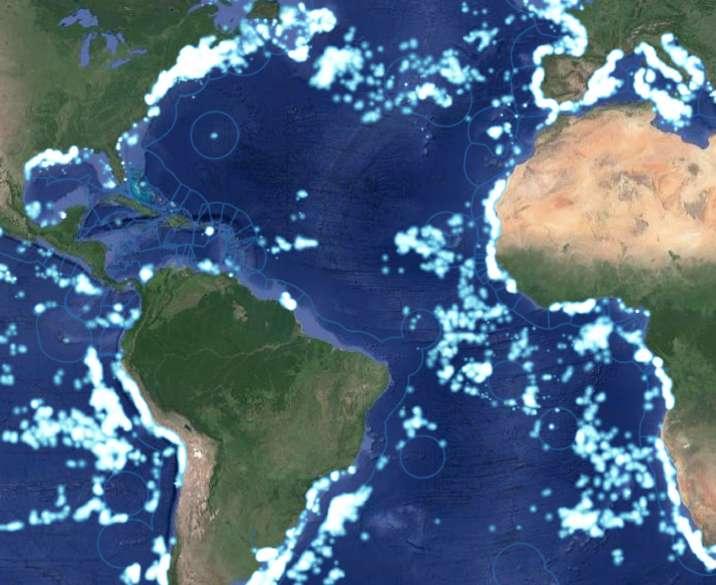AIS WHAT IS IT?
Automatic Identification System (AIS) is a tracking system that automatically transmits a vessel's identity, speed and GPS location.
Automatic Identification System

OCEANA.ORG
AIS
WHAT
IS AIS USED FOR?
SAFETY
Initially developed to prevent collisions at sea

INFORMATION
MONITORING AIS
Exchange navigational data
Locate and identify vessels, track movements AIS
DOES AIS WORK? HOW
AIS devices automatically send a ship’s direction, sp eed, location and identification information to other AIS devices, land-based receivers and satellites as frequently as every...
2-30 SECONDS UP TO 43,200x A DAY
vessels
PUBLIC
The AIS transmissions are public and provide data of vessel locations around the world

TRANSPARENT
Vessels using AIS broadcast their whereabouts and identity
Global Fishing Watch provides the first global view of commercial fishing activity in near real-time, for free.
EFFECTIVE
Global Fishing Watch uses this data to show the public when and where vessels are likely fishing worldwide
Visit globalfishingwatch.org
AIS
land-based receivers satellites
GLOBAL FISHING WATCH
USES AIS? WHO
Over
300,000 vessels including:
More than 70,000 shing vessels responsible for most of the world's fish catch

IS AIS REQUIRED? WHERE
The International Maritime Organization requires large vessels to carry AIS. However, governments can decide if — and to what extent — these requirements apply to fishing vessels
The United States requires its fishing vessels over 65 feet long, or about 20 meters, to have AIS.
The European Union requires its fishing vessels over 15 meters, or about 49 feet long, to have AIS.

65‘/20m 49‘/15m
AIS
ADVANTAGES
VULNERABILITIES
Transparency at sea—view the locations and movements of fishing vessels

Researchers, advocates, governments and others can use Global Fishing Watch to monitor fishing vessels and fishing activities
of AIS A B C
associated with AIS
Not all vessels are required to use AIS
A ship’s crew can tamper with their AIS, sending false information or even turning the AIS device off
Without AIS, a vessel is essentially invisible to the public
Coastal nations can better monitor their waters OFF
ADVANTAGES
VULNERABILITIES
Transparency at sea—view the locations and movements of fishing vessels

Researchers, advocates, governments and others can use Global Fishing Watch to monitor fishing vessels and fishing activities
of AIS A B C
associated with AIS
Not all vessels are required to use AIS
A ship’s crew can tamper with their AIS, sending false information or even turning the AIS device off
Without AIS, a vessel is essentially invisible to the public
Coastal nations can better monitor their waters OFF
WHY IS AIS IMPORTANT?
SAFETY
Safeguard vessels at sea
Discourage illicit behaviors at sea like illegal fishing and human rights abuses

MONITOR
Visibility enables accountability
DETER
OCEANA’S PROPOSED SOLUTIONS
REQUIRE
Governments require all commercial fishing vessels flying their flag or operating within their national waters to carry and continually broadcast publicly accessible, tamper-resistant AIS.

ENFORCE
Flag states and coastal states enforce existing AIS requirements.
AIS
All regional fisheries management organizations require AIS usage by any commercial vessel operating in their territories.
Oceana

Require vessel owners to notify the flag state and/or coastal state when and why their fishing vessel operator stops transmitting AIS.
Flag State: The country under which a vessel is registered
works to help stop illegal fishing , advocate for transparency at sea, and require traceability of all seafood.
NOTIFY
POLICE



